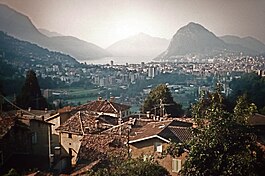Canobbio
| Canobbio | ||
|---|---|---|
 |
||
|
||
| Coordinates: 46°2′N 8°58′E / 46.033°N 8.967°ECoordinates: 46°2′N 8°58′E / 46.033°N 8.967°E | ||
| Country | Switzerland | |
| Canton | Ticino | |
| District | Lugano | |
| Government | ||
| • Mayor | Sindaco | |
| Area | ||
| • Total | 1.3 km2 (0.5 sq mi) | |
| Elevation | 405 m (1,329 ft) | |
| Population (Dec 2015) | ||
| • Total | 2,137 | |
| • Density | 1,600/km2 (4,300/sq mi) | |
| Postal code | 6952 | |
| SFOS number | 5167 | |
| Localities | Corba, Ganna, Maglio, Cartiera–Ponte di Valle | |
| Surrounded by | Cadro, Capriasca, Comano, Lugano, Porza | |
| Website |
www SFSO statistics |
|
Canobbio is a municipality in the circolo Vezia of the district of Lugano in the canton of Ticino in Switzerland
Roman era inscription and cremation graves from the 3rd Century AD indicate that there was an earlier settlement near the modern village. Canobbio is first mentioned in 712 as Canobli. During the Middle Ages it was a farm of the Abbey of S. Ambrogio in Milan. The Church of S. Siro, is first mentioned 863. It belonged to the Abbey of San Pietro in Ciel d'Oro in Pavia. The settlement of Conago is first mentioned in 1335 along with its church of San Silvestro. The Humiliati monastery of S. Caterina in Lugano also owned land in Canobbio. In 1472 the village church in Canobbio separated from the mother church in Lugano (1472) and was incorporated in the parish of Comano. It became an independent parish in 1643.
In Canobbio there were two mills, the oldest was owned by the Pocobelli family (1712), and then by Fumagalli family. It was rebuilt in 1900 in brick. The younger mill was built in 1848, for the De Marchi family of Astano and later the Bernasconi from Chiasso. In 1870 the Baron Paul von Dervies, a Russian banker and railroad magnate built the Castello di Trevano as a temple to music, in the vicinity of Canobbio, with a private orchestra of 52 players. Between 1960 and 1990 the number of inhabitants doubled. The number of jobs in the services sector is increasing.
Canobbio is home to a district school and a popular shopping center.
Canobbio has an area, as of 1997[update], of 1.3 square kilometers (0.50 sq mi). Of this area, 0.38 km2 (0.15 sq mi) or 29.2% is used for agricultural purposes, while 0.49 km2 (0.19 sq mi) or 37.7% is forested. Of the rest of the land, 0.66 km2 (0.25 sq mi) or 50.8% is settled (buildings or roads), 0.03 km2 (7.4 acres) or 2.3% is either rivers or lakes and 0.03 km2 (7.4 acres) or 2.3% is unproductive land.
...
Wikipedia




